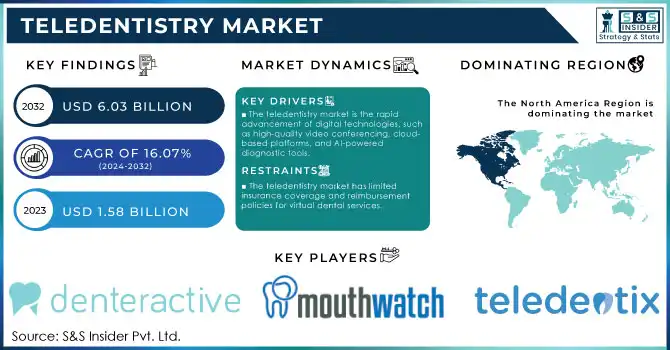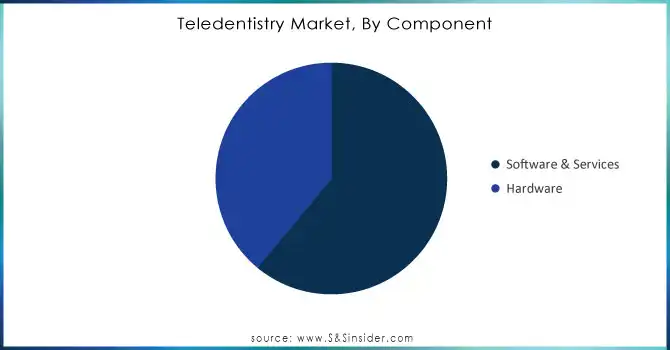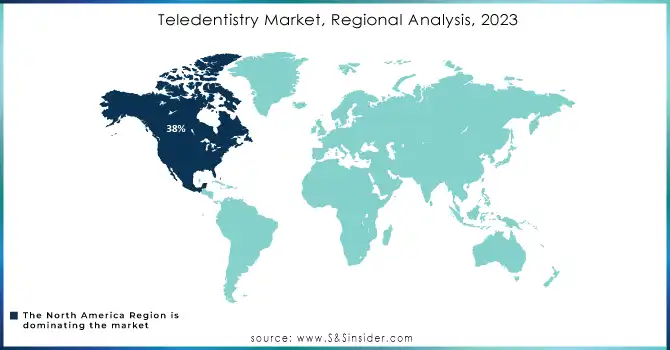Teledentistry Market Size:
The Teledentistry Market size was valued at USD 1.83 billion in 2024, expected to reach USD 6.03 billion by 2032, growing at a CAGR of 16.07% from 2025-2032.

Get More Information on Teledentistry Market - Request Sample Report
The teledentistry market is rising as an essential part of digital healthcare, offering dental services and consultations remotely via digital platforms. This method is revolutionizing the conventional dental care model, enhancing the accessibility and convenience of dental services, especially for patients in isolated or neglected areas. Teledentistry enables patients to obtain dental consultations, diagnoses, treatment planning, and education while staying in their homes. Along with aiding patients, it lessens the strain on dental practitioners and clinics by decreasing unwarranted in-office appointments.
The market features the rise of Artificial Intelligence (AI)--powered tools that assist dentists in providing more accurate diagnoses and customized treatment. For instance, Pearl, a dental technology startup focusing on AI, has recently launched a range of AI diagnostic tools designed to improve dental imaging assessments and advance teledentistry appointments.
Market Size and Forecast:
-
Market Size in 2024 USD 1.83 Billion
-
Market Size by 2032 USD 6.03 Billion
-
CAGR of 16.07% From 2025 to 2032
-
Base Year 2024
-
Forecast Period 2025-2032
-
Historical Data 2021-2023
Teledentistry Market Trends:
-
Rapid adoption of digital technologies, including high-quality video conferencing, cloud platforms, and AI-powered diagnostic tools.
-
Increased efficiency, accuracy, and accessibility of remote dental consultations through advanced teledentistry solutions.
-
Growing patient preference for convenient, budget-friendly, and time-saving remote healthcare services.
-
Expansion of teledentistry in rural and underserved areas to address limited access to dental professionals.
-
Integration of AI in dental imaging and diagnostics, enhancing precision in identifying dental issues remotely.
Teledentistry Market Growth Drivers:
-
The teledentistry market is the rapid advancement of digital technologies, such as high-quality video conferencing, cloud-based platforms, and AI-powered diagnostic tools.
The advancements have enhanced the efficiency, security, and accessibility of remote dental consultations. As high-speed internet becomes increasingly common and budget-friendly, patients can conveniently utilize teledentistry services, obtaining consultations, diagnoses, and treatment suggestions from their dentists without requiring physical appointments. The incorporation of Artificial Intelligence in dental imaging and diagnostics is improving the accuracy of teledentistry, enabling dentists to identify problems such as cavities or gum disease from a distance with increased precision.
-
Increased Demand for Convenient and Accessible Healthcare
The demand for more accessible healthcare alternatives is rising, fueled by patients’ growing inclination towards remote services. This change is especially pronounced in areas with restricted access to healthcare services or where conventional dental treatment is costly or requires a lot of time. Teledentistry tackles these issues by providing online consultations, and minimizing travel time and related expenses. Moreover, teledentistry facilitates access to dental care for patients in rural or underserved communities, tackling the lack of dental professionals in those areas. The capacity to oversee dental care from a distance, such as follow-ups and preventive check-ups, is motivating patients to use teledentistry services, thereby boosting the market's expansion.
Teledentistry Market Restraints:
-
The teledentistry market has limited insurance coverage and reimbursement policies for virtual dental services.
Though telehealth services overall have seen increased acceptance, numerous insurance companies and healthcare organizations remain reluctant to include teledentistry consultations in their coverage or restrict their extent. This is especially clear in areas where dental insurance plans have not completely adjusted to the digital healthcare framework. In certain instances, insurance companies might only reimburse for face-to-face appointments, forcing patients to cover the costs of online consultations themselves. Consequently, the absence of thorough reimbursement frameworks can obstruct the broad acceptance of teledentistry, especially among low-income patients or those depending on insurance to handle healthcare expenses.
Teledentistry Market Segment Analysis:
By Component
The software and services segment dominated the market by 58% and held the highest revenue share in 2024. This can be attributed to the increasing use of wirelessly connected care technologies in dental health, efforts by major companies, and the abundant availability of various dental software and services. The growing adoption of teledentistry software by individuals seeking convenience and affordability is expected to propel the market during the forecast period. Additionally, progress in digital health technology, with accessible telehealth platforms, mobile apps, and AI-powered diagnostic tools, is improving the patient experience and broadening the range of services available.
The hardware segment is expected to experience the fastest growth, throughout the forecast period, driven by technological innovations in introducing new dental care hardware to the market. Certain dental devices, like electric toothbrushes that provide oral health feedback to teledentistry platforms, significantly enhance the therapeutic use of tele-dental methods. For example, Koninklijke Philips N.V.’s Sonicare teledentistry system includes an electric toothbrush as dental equipment that allows individuals to track their oral health.

Need Any Customization Research On Teledentistry Market - Inquiry Now
By Delivery Mode
The cloud-based segment dominated the market, capturing the highest revenue share in 2024, and is expected to expand at a CAGR of 18.21%. The elements driving the expansion involve the launch of cutting-edge cloud-computing teledentistry services and a rise in awareness among dental professionals and patients to utilize cloud-based applications for effortlessly recording and storing health information. Moreover, convenient access combined with ample bandwidth, storage, and recovery capabilities along with strong safety guarantees is driving the expansion of the segment.
The web segment is expected to experience the highest CAGR from 2025 to 2032 due to the rise of web-based teledentistry apps and their extensive acceptance by end-users. The widespread use of smartphones in rural and isolated areas is improving access to dental care. The affordable pricing and smooth user experience provided by this virtual care platform are driving the swift expansion of the sector.
By Application
The teleconsultation segment dominated the market, capturing the highest revenue share of 45% in 2024. The growing awareness of oral health problems, along with the need for quick access to dental experts, fuels the use of virtual consultations. Numerous dentists embraced teledentistry to offer online consultations about dental health by connecting with patients from afar. The incorporation of AI and machine learning into teledentistry applications is transforming diagnostics and treatment strategies. Additionally, teleconsultation platforms are progressively integrating features that boost patient involvement, including interactive educational materials, reminders for maintaining oral hygiene, and gamification aspects to promote compliance with treatment plans.
The remote patient monitoring segment is expected to experience the highest CAGR from 2025 to 2032 due to the increasing awareness of dental health among adults, along with the ease of receiving dental care from home. The presence of numerous self-monitoring dental care applications along with devices is enabling individuals to achieve oral hygiene without visiting dentists. These factors are expected to enhance segment growth.
By End-Use
The provider segment dominated the market, capturing the highest revenue share of 49% in 2024, driven by the increasing adoption of teledentistry platforms by dental providers to alleviate the disease burden on dental facilities. Moreover, the teledentistry software allows for effortless access to patients’ dental records through enhanced data management and real-time quality reporting, which increases its adoption by healthcare providers. Furthermore, the increasing focus on patient-centered care approaches prompts providers to adopt teledentistry to enhance access for patients with mobility challenges or those residing in distant regions.
The patient segment is expected to experience the highest CAGR between 2025 and 2032 due to the rising number of smartphone users and the increasing number of active subscribers to teledentistry services. Moreover, the improved accessibility due to high internet connectivity, practicality, and cost-effectiveness of dental consultations via virtual means is leading individuals to prefer these platforms over in-person dental visits.
Teledentistry Market Regional Analysis:
North America Teledentistry Market Insights
North America dominated the market in teledentistry, capturing the highest revenue share of 38% in 2024. North America is among the earliest areas to embrace smart healthcare innovations, integrating technologies like smart wearables, mobile applications, and eHealth services such as teledentistry and Electronic Health Record (EHR) platforms for remote access to information on diverse health issues. The rising usage of smartphones is propelling market expansion. Increasing recognition of existing digital health solutions like telehealth, teledentistry, and mHealth is accelerating their adoption rate. The increase in the younger demographic that is more aware and inclined towards digital health, along with rising disposable income, can be credited with the significant market share.
Asia Pacific Teledentistry Market Insights
Asia Pacific region is expected to experience the highest growth rate throughout the forecast period in the teledentistry market. Primary market participants are formulating plans to grow their operations in this area. Market expansion is anticipated to be propelled by beneficial actions taken by key stakeholders, including the education of healthcare practitioners and heightened R&D funding to create innovative teledentistry technologies.The increasing elderly population in the nation is driving market expansion. The increasing occurrence of dental issues and ongoing technological progress are key factors anticipated to boost the need for tele-intensive care units. Increasing government efforts to boost the adoption of telehealth solutions in various areas are contributing to market growth.
Europe Teledentistry Market Insights
Europe’s teledentistry market is growing steadily, driven by high digital infrastructure, widespread internet access, and increasing adoption of AI-powered dental solutions. Government initiatives promoting remote healthcare, coupled with rising demand for convenient and cost-effective dental services, support market expansion. Urban and rural populations increasingly leverage teledentistry for consultations, follow-ups, and preventive care, strengthening Europe’s position as a key market for digital dental services.
Latin America (LATAM) and Middle East & Africa (MEA) Teledentistry Market Insights
The LATAM and MEA teledentistry markets are expanding due to limited access to traditional dental care and increasing smartphone penetration. Governments and private providers are promoting remote dental services to improve oral health in underserved regions. Affordable, convenient, and accessible teledentistry solutions help reduce travel costs and enhance patient care, driving adoption and creating growth opportunities across these regions.

Teledentistry Market Key Players:
-
Teledentix (Teledentix Platform, Teledentix Remote Patient Monitoring)
-
SmileDirectClub (SmileDirectClub App, SmileDirectClub Aligner Kit)
-
MouthWatch (Teledentistry Software, Intraoral Cameras)
-
Denteractive (Denteractive Platform, Denteractive Telemedicine App)
-
Virtudent (Virtudent Telehealth Platform, Virtudent Intraoral Camera)
-
Carestream Dental (Carestream Health Software, CS 3700 Intraoral Scanner)
-
Patterson Dental (iTero Intraoral Scanner, OrthoAligner)
-
MediSprout (Telehealth Solutions, Remote Patient Monitoring Tools)
-
Teledentistry.com (Teledentistry Portal, Mobile App)
-
Callforce (Callforce Teledentistry Solutions, Virtual Office Solutions)
-
Dentulu (Dentulu Teledentistry Platform, Dentulu Intraoral Camera)
-
Opencare (Opencare Teledentistry App, Virtual Care Tools)
-
Teledentics (Teledentics Platform, Teledentics Intraoral Camera)
-
Dental Monitoring (Dental Monitoring App, Intraoral Camera)
-
Opgal (Opgal Teledentistry Solutions, Opgal Mobile Imaging)
-
Align Technology (Invisalign, iTero Element Scanner)
-
Pearl (Pearl AI Software, Pearl Virtual Consultation Platform)
-
Teledentistry Network (Teledentistry Platform, Virtual Dental Exam Kit)
-
TrueDent (TrueDent Telehealth Platform, TrueDent Treatment Plan)
-
Zocdoc (Zocdoc Appointment Scheduling, Zocdoc Virtual Visit)
Competitive Landscape for Teledentistry Market:
Delta Dental of California and its subsidiaries is a leading dental insurance provider offering comprehensive coverage for individuals, families, and employers. The company focuses on improving oral health through accessible, affordable dental plans and preventive care programs. With extensive provider networks and digital solutions, Delta Dental enhances patient convenience, supports timely treatments, and plays a pivotal role in advancing oral healthcare across California.
-
In August 2024, Delta Dental of California and its subsidiaries (DDCA), the leading dental insurance provider serving over 31 million members, collaborated with Teledentistry.com to provide members with virtual access to dental professionals around the clock, focusing on overcoming barriers to care, especially for those in urgent need.
Virtual Dental Care, Inc. is a teledentistry provider delivering remote dental consultations, diagnostics, and treatment planning through digital platforms. The company leverages video conferencing, AI-powered imaging, and cloud-based solutions to enhance accessibility and efficiency of dental care. By offering convenient, cost-effective, and timely services, Virtual Dental Care supports patients in underserved and remote areas while driving innovation in the teledentistry market.
-
In June 2023, Virtual Dental Care, Inc., a provider of digital dental solutions, unveiled its groundbreaking Teledentistry 3.0 service, Dental.com, which allows patients to access thorough dental care from the convenience of their own homes.
| Report Attributes | Details |
|---|---|
| Market Size in 2024 | USD 1.83 Billion |
| Market Size by 2032 | USD 6.03 Billion |
| CAGR | CAGR of 16.07% From 2025 to 2032 |
| Base Year | 2024 |
| Forecast Period | 2025-2032 |
| Historical Data | 2021-2023 |
| Report Scope & Coverage | Market Size, Segments Analysis, Competitive Landscape, Regional Analysis, DROC & SWOT Analysis, Forecast Outlook |
| Key Segments | •By Component (Software & Services, Hardware) •By Delivery Mode (Cloud-Based, Web-Based) •By Application (Tele-Consultation, Remote Patient Monitoring, Education & Training) • By End-Use (Providers, Patients, Others) |
| Regional Analysis/Coverage | North America (US, Canada), Europe (Germany, UK, France, Italy, Spain, Russia, Poland, Rest of Europe), Asia Pacific (China, India, Japan, South Korea, Australia, ASEAN Countries, Rest of Asia Pacific), Middle East & Africa (UAE, Saudi Arabia, Qatar, South Africa, Rest of Middle East & Africa), Latin America (Brazil, Argentina, Mexico, Colombia, Rest of Latin America). |
| Company Profiles | Teledentix, SmileDirectClub, MouthWatch, Denteractive, Virtudent, Carestream Dental, Patterson Dental, MediSprout, Teledentistry.com, Callforce, Dentulu, Opencare, Teledentics, Dental Monitoring, Opgal, Align Technology, Pearl, Teledentistry Network, TrueDent, Zocdoc, and other players |

